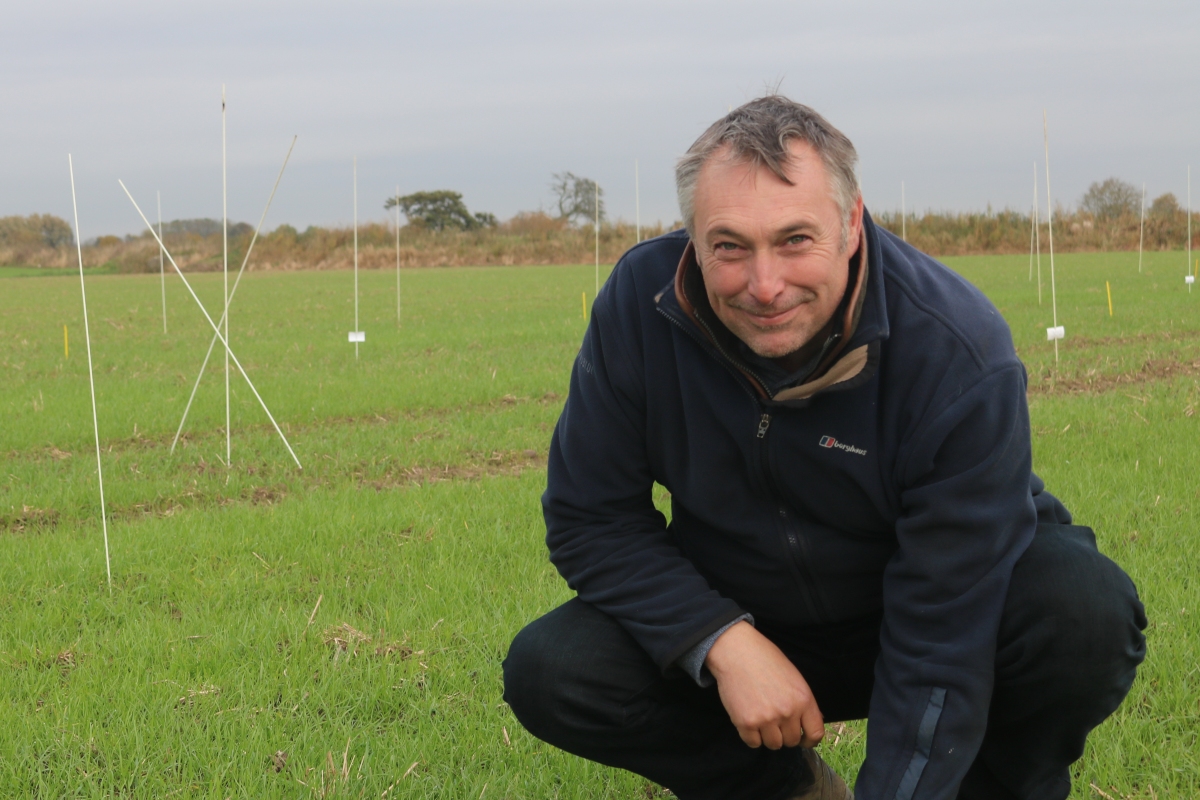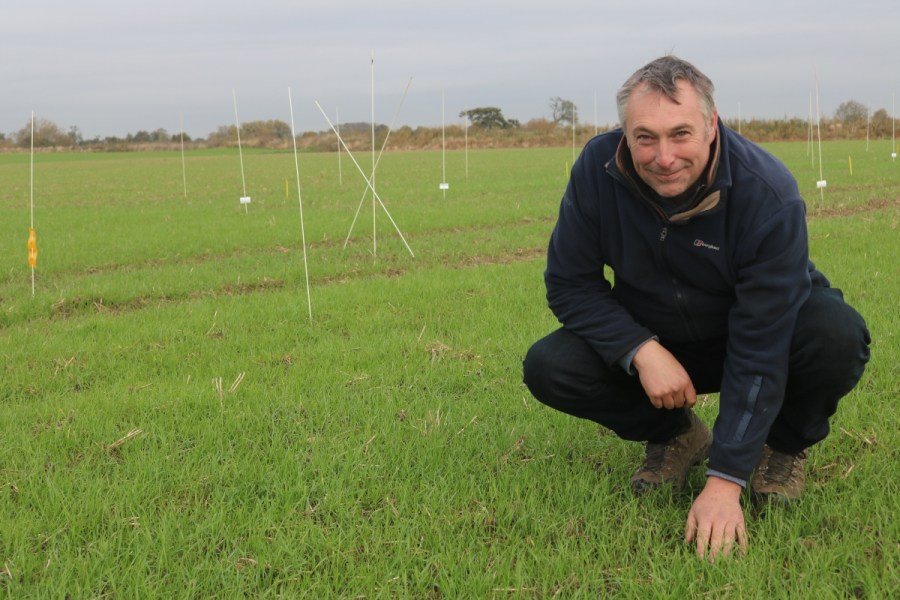
A new addition to the herbicide toolbox presents opportunities for growers grappling with grassweeds. CPM visits a North Yorks trial site with a Real Results pioneer to discuss how to refine strategies.
Controlling grassweeds is like a game of snakes and ladders.
By Tom Allen-Stevens
Looking across the grassweed trial site at Kirk Hammerton, N Yorks, it’s pretty obvious where the best of the new chemistry has been applied. In places, there’s a lawn of the RRR-resistant ryegrass, while in some of the plots, there’s barely a plant out of place.
For local grower and NIAB TAG agronomist Julian Thirsk, it’s something of an eye-opener. “It’s great to be able to see a proper herbicide trial site at last – I don’t think I’ve visited a Luximo trial since 2019, and that wasn’t a good year for trials.”
Julian’s referring to the new pre-emergence herbicide, based on the active ingredient cinmethylin (see panel on pxx). Noted for its entirely new mode of action on grassweeds, it’s currently still awaiting approval for use, expected to be available commercially in time for autumn 2022, and it’s currently in trials across the UK.
This includes a number of Real Results trials. For the past five years, Julian has been one of 50 farmers across the country in BASF’s Real Results Circle, carrying out tramline trials with the latest chemistry. This is compared with the farm’s standard best practice treatment and the results are put through a fair degree of scientific scrutiny to ensure a result that’s ‘real’.
Local BASF agronomy manager Mathew Barnes has arrived to talk through the trials, and joins the discussion on grassweed issues in the area and how new chemistry will fit in to keep it under control. “As well as the Real Results tramline trials, we have two ryegrass sites and two testing Luximo on blackgrass as well as a weed screen in Yorks. It’s a programme that’s replicated across the UK, so every agronomist should get the chance to see a trial.”
But Julian’s realistic about what the new chemistry will achieve. “Controlling grassweeds is like a game of snakes and ladders. Luximo gives us another ladder, but there are still plenty of snakes, and you need to be just as vigilant to avoid them,” he says.
He farms in a family partnership across 300ha of arable land near Selby. The soil type varies from blow-away sand to heavy clay with plenty of silt, on land that’s seen a lot of marling in previous times. On the lighter soils, sugar beet and potatoes (on land rented out) slot in with peas and oilseed rape as break crops rotated with wheat and hybrid barley. The spring breaks are used strategically to help against grassweeds.
“We have a zero-tolerance approach to blackgrass – any patch that appears is sprayed out,” says Julian. “The biggest issue we have is contractors bringing it in on the combine or balers. So we ask them to blow down equipment before coming on the farm. But it’s only really a problem on the heavier land – lighter soils are easier to keep blackgrass-free.”
Mathew notes that good weed-seed hygiene – keeping blackgrass from spreading into the area and contained within fields where it appears – is a key priority. “On the Wolds, there are many areas completely clear of blackgrass, so keeping them that way is so important.
“The Wold soils also tend to suit later drilling, which is another key defence against blackgrass. This year we’ve had a very kind autumn, and on the whole I think growers resisted the urge to get the drill out too early, although the shortage of glyphosate hasn’t helped in achieving stale seedbeds.”
With most crops established with minimum tillage, Julian calls himself a “luddite when it comes to cultivations”, with the plough keeping its place. “There’s no strict policy, although we’ll plough much of the lighter land, and always plough in front of barley – sterile brome is a big problem, and there’s no chemistry you can use against it in barley.
“The other issue I have with direct drilling is the crops don’t close their canopy so well. You may not be disturbing the soil, but you’re allowing light into the base of the crop that encourages blackgrass and brome.”
As well as his own farm, Julian provides agronomy advice over an area that stretches from S Yorks to Northumberland. “Generally most growers know what they’re dealing with – crops have been established in good conditions and the pre-emergence herbicides have gone on. It’s another low dormancy year, which may lead to late-germinating blackgrass.”
The Real Result trial field itself is not on Julian’s farm, but on one nearby at Terrington. “It’s a field of heavy clay – blackgrass has always been there in the background and it’s grown into a problem,” he says.
A 30ha field, KWS Siskin winter wheat follows beans. “The surface was only lightly worked to get a seedbed – we didn’t want to disturb it too much. The difficulty was getting a flush of blackgrass to take out with the glyphosate before drilling. Just as the field was about to be drilled, some came through, so we delayed by a week. It was eventually drilled at the end of October, but followed by 30-40mm of rain and the pre-em was delayed.”
Two tramlines have been treated with Luximo, while the rest of the field has received the farm standard – 4.0 l/ha of Crystal with 0.2 l/ha diflufenican. Avadex (triallate) was applied in good time, but the main pre-em was applied when the crop was already at two leaves emerged.
For Mathew, it’ll be an interesting test of Luximo, although far from ideal. “You’ll always see a lift in efficacy with Luximo, but it’s no silver bullet. You still have to get everything else right, and good application at the right timing are key – pre-emergence of the crop is where you should put your best chemistry.”
And that experience is borne out on the trail site – ryegrass is the main issue with a background population over 300/m². Mathew points out two plots, thick with survivors, that were sprayed when the weed had already reached 2-3 leaves. “Ryegrass is a particular strength of Luximo, and we’re typically seeing an uplift of 15-20%. But the biggest contribution to grassweed control comes from an holistic, IPM approach – the herbicide is just the icing on the cake,” he notes.
Vigilance is the watchword as grassweed challenges evolve
Keep a close eye on grassweeds and monitor any populations that come through, recommends BASF’s Paul Haynes. “My advice is to stay vigilant,” he says.
“I suspect there were a lot of drills under starter’s orders this autumn, and generally growers have made good use of favourable conditions to get crops underway at sensible timings into good seedbeds. But there are fresh challenges, and no room for complacency.”
One of these is the evolving picture on grassweeds. “Ryegrass is becoming a key issue for many growers. It’s important firstly to identify any populations you have and determine their resistance status,” he says.
“Brome is another problem becoming increasingly tricky – the focus on stale seedbeds for blackgrass can encourage populations of soft, meadow and rye brome, so again good monitoring, including correct species identification is important.
“A relatively new and rising threat is rat’s-tail fescue – we’re keeping this under observation in some of our trials,” adds Paul.
The dormancy status of blackgrass and good growing conditions late into the autumn will increase the chances of late-germinating grassweeds, and a herbicide top-up before Christmas or early in the New Year may be advisable, he suggests.
“The limit for pendimethalin is 2000g/ha over the season, while the total for flufenacet is 360g/ha. Any follow-up treatments must be made in line with label recommendations.”
Looking ahead, Luximo will present further control options for growers to improve their strategy next autumn, “but it’s a refinement, not a silver bullet,” Paul stresses.
“The most effective strategy puts your key product first, with other chemistry complementing it. Luximo is in a different chemical class with a new mode of action, so should be the prime active at the pre-em timing. Crystal will then build in behind it – we’ll be using trials evidence gleaned this season to refine our advice on how best to amend strategies.
“It’s good news for resistance management, though – unlike with fungicides, we’re not losing a raft of older chemistry with this new addition. So growers can use Luximo, in conjunction with other chemistry and cultural control techniques, both to enhance efficacy and manage better the resistance status of grassweed populations,” he concludes.
- For more on Luximo, blackgrass and soil advice from top UK experts captured in podcasts and videos, go to the BASF Real Results Virtual Farm www.basfrealresultsfarm.com
The Real Results Circle
BASF’s Real Results Circle farmer-led trials are now in their fifth year. The initiative is focused on working with 50 farmers to conduct field-scale trials on their own farms using their own kit and management systems. The trials are all assessed using ADAS’ Agronomics tool which delivers statistical confidence to tramline, or field-wide treatment comparisons – an important part of Real Results.
In this series we follow the journey, thinking and results from farmers involved in the programme. The features also look at some in-depth related topics, such as SDHI performance and data capture and use.
We want farmers to share their knowledge and conduct on-farm trials. By coming together to face challenges as one, we can find out what really works and shape the future of UK agriculture.
To keep in touch with the progress of these growers and the trials, go to www.basfrealresults.co.uk or scan the QR code to visit the all-new, cereal fungicide virtual trial, offering a 360° map to compare plots.




